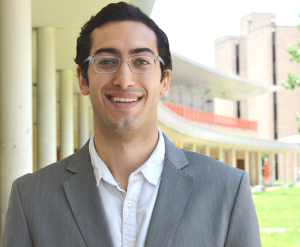Kian Torabian, a biomedical engineering doctoral student at the UH Cullen College of Engineering, will bring his innovative Sickle Cell Disease research to France as a 2016 recipient of the STEM Chateaubriand Fellowship.
The Fellowship, offered by the Office for Science and Technology of the Embassy of France in Washington D.C., aims to initiate and reinforce collaborations, partnerships and joint projects between French and American research teams.
At the Cullen College, Torabian works in the Blood Microfluidic Laboratory led by biomedical engineering professor Sergey Shevkoplyas developing highly-innovative technologies for diagnosing and monitoring the severity of Sickle Cell Disease, or SCD. Torabian applied novel microfluidic techniques developed in the lab to study the deformability of red blood cells in the two most common forms of SCD—HbSS and HbSC— in order to better understand the differences between the two forms of the disease.
For the duration of the six-month fellowship, Torabian will work with Philippe Connes, professor of physiology and head of the Vascular Biology and Red Blood Cell team in the LIBM laboratory at Université de Lyon, and Connes’s collaborator Manouk Abkarian, a physicist studying red blood cell biophysics and microfluidics from the Université de Montpellier’s Center for Structural Biochemistry.
Torabian said his proposal for the fellowship was inspired by a project previously led by Connes and Abkarian, in which they studied how sickle red blood cells from HbSS patients flow, aggregate and adhere in microchannels. Excited to expand upon this research, Torabian proposed integrating microfluidic techniques developed in Shevkoplyas' laboratory at the Cullen College with clinical research on red blood cell biochemistry and biophysics conducted in the Connes and Abkarian laboratories to study how red blood cells from patients with the HbSC form of the disease may interact within the microvasculature.
“I thought it would be really interesting to explore a project that would integrate the extensive knowledge about the deformability of red blood cells that has been accumulated in our various laboratories,” he said. “I think we have the potential to take the expertise from multiple labs and do something that hasn’t really been done before.”
SCD is an inherited disorder that causes oxygen-carrying red blood cells to become misshapen, affecting the normal flow of blood. SCD patients suffer from an array of complications as a result of the disease, including chronic anemia, pain caused by vaso-occlusives crises, fatigue, infections, stroke and premature death.
SCD affects about 100,000 people in the U.S. and is considered a rare disease, which limits the amount of research funding devoted to finding better treatments for patients suffering from SCD.
HbSS, also known as sickle cell anemia, is the most common form of SCD, affecting approximately 60-70 percent of SCD patients. The effects of HbSS are often more acute than the effects of HbSC, and cause more severe symptoms which often result in shorter lifespans for patients. Because of this, there is substantially more research conducted on HbSS than HbSC and there are currently more effective treatment options available to HbSS patients.
Though HbSC affects fewer patients overall—approximately 30 percent of SCD patients—and the individual effects are generally less severe, HbSC patients typically have longer lifespans than HbSS patients and, over time, the chronic symptoms of the disease can have devastating impacts on the patients’ overall health and quality of life. Many HbSC patients suffer from organ damage later in life, due to the long-term impact of mild anemia and restricted blood flow.
Ultimately, the goal of this collaborative, multi-scale study is to develop targeted diagnostics, therapeutics and better monitoring tools for patients with SCD.
“Though SCD has been biologically interesting for researchers, it has been somewhat neglected from a therapy and diagnostic standpoint—until now,” said Torabian. “I’m excited to be part of a new wave of international researchers moving the study of SCD forward using multidisciplinary approaches.”
